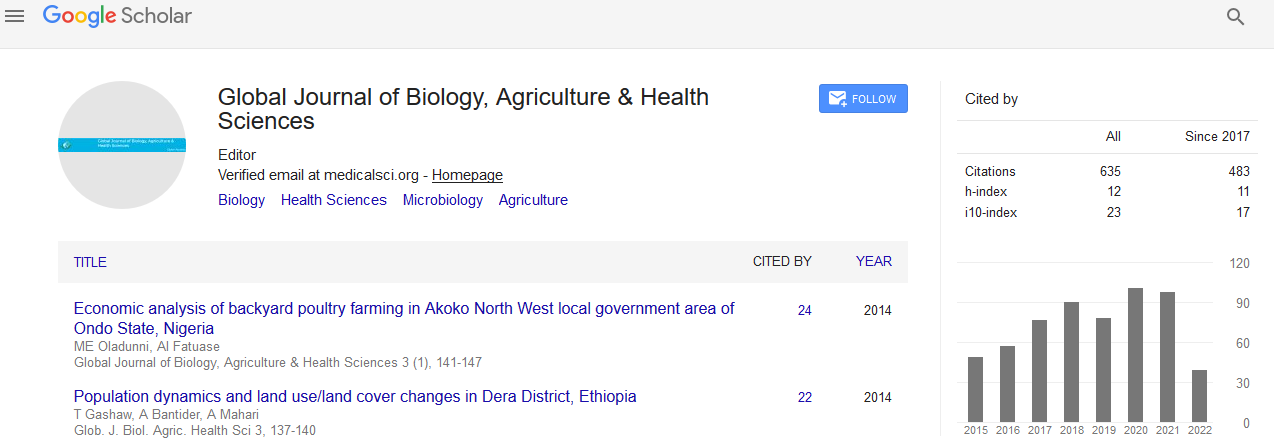Indexed In
- Euro Pub
- Google Scholar
Useful Links
Share This Page
Journal Flyer

Open Access Journals
- Agri and Aquaculture
- Biochemistry
- Bioinformatics & Systems Biology
- Business & Management
- Chemistry
- Clinical Sciences
- Engineering
- Food & Nutrition
- General Science
- Genetics & Molecular Biology
- Immunology & Microbiology
- Medical Sciences
- Neuroscience & Psychology
- Nursing & Health Care
- Pharmaceutical Sciences
Perspective - (2024) Volume 13, Issue 4
Impact of Biological Macromolecules on Disease and Therapy
Henna Battista*Received: 27-Nov-2024, Manuscript No. GJHABS-24-28141; Editor assigned: 29-Nov-2024, Pre QC No. GJHABS-24-28141 (PQ); Reviewed: 13-Dec-2024, QC No. GJHABS-24-28141; Revised: 20-Dec-2024, Manuscript No. GJHABS-24-28141 (R); Published: 27-Dec-2024, DOI: 10.35248/2319-5584.24.13.233
Description
Biological macromolecules are fundamental to the structure and function of all living organisms. Their roles in disease and therapy have garnered significant attention due to their contributions to understanding pathological processes and developing innovative treatments. This article examines into the impact of carbohydrates, lipids, proteins and nucleic acids on disease mechanisms and therapeutic strategies, providing a comprehensive overview of their importance in the biological and medical sciences.
Carbohydrates are organic molecules composed of carbon, hydrogen and oxygen that serve as energy sources, structural components and mediators of cellular communication. In the context of disease, aberrations in carbohydrate metabolism can lead to conditions such as diabetes mellitus, where the regulation of glucose is impaired. Glycated proteins, such as hemoglobin A1c, are markers used to monitor long-term glucose levels in diabetic patients. Additionally, alterations in glycosylation patterns are linked to cancer progression and immune evasion. Therapeutically, carbohydrates play a role in vaccine development and drug delivery. For instance, polysaccharide-based vaccines are employed to prevent bacterial infections such as those caused by Streptococcus pneumoniae.
Lipids, a diverse group of hydrophobic molecules, are vital for energy storage, membrane structure and signaling. Dysregulation of lipid metabolism is associated with numerous diseases, including cardiovascular disorders, obesity and neurodegenerative conditions. Atherosclerosis, a leading cause of heart disease, involves the accumulation of lipids and inflammatory cells within arterial walls. In Alzheimer’s disease, changes in lipid composition and metabolism contribute to the formation of amyloid plaques and neuroinflammation. Advances in lipidomics have enhanced the understanding of lipid roles in health and disease, aiding the development of therapeutic approaches. Lipid based drug delivery systems, such as liposomes, are widely used to enhance the bioavailability and efficacy of pharmaceuticals.
Proteins, composed of amino acids, perform diverse functions, including enzymatic catalysis, structural support and cellular signaling. Mutations or misfolding of proteins are implicated in a wide range of diseases. For example, sickle cell anemia arises from a single amino acid substitution in hemoglobin, leading to altered red blood cell shape and function. Similarly, the aggregation of misfolded proteins, such as beta-amyloid in Alzheimer’s disease and alpha-synuclein in Parkinson’s disease, is central to the pathogenesis of these neurodegenerative conditions. Therapeutic interventions targeting proteins include enzyme replacement therapy, monoclonal antibodies and smallmolecule inhibitors. Proteomics, the large-scale study of proteins, has revolutionized the identification of disease biomarkers and therapeutic targets, paving the path for precision medicine.
Nucleic acids, including DNA and RNA, are the genetic material responsible for storing and transmitting hereditary information. Mutations or alterations in nucleic acids can result in genetic disorders and contribute to the development of cancer and other diseases. For example, mutations in tumor suppressor genes such as TP53 or BRCA1 increase susceptibility to certain cancers. RNAbased therapies, such as small interfering RNAs and antisense oligonucleotides, offer innovative strategies to modulate gene expression and treat genetic diseases. The advent of CRISPR-Cas9 technology has enabled precise genome editing, providing a powerful tool for correcting genetic defects and advancing therapeutic development. Additionally, mRNA vaccines have demonstrated efficacy in preventing infectious diseases, exemplified by their success during the COVID-19 pandemic.
Interactions among macromolecules are integral to maintaining homeostasis and driving pathological processes. For example, the interaction between proteins and nucleic acids governs gene interaction, while lipids and carbohydrates contribute to cellular membrane structure and function. Disruptions in these interactions can lead to diseases such as metabolic syndrome, where altered carbohydrate and lipid metabolism is a key feature. Understanding these molecular interactions is essential for identifying potential therapeutic targets and designing effective treatments.
Advances in analytical techniques have facilitated the study of biological macromolecules, enhancing the understanding of their roles in disease and therapy. Techniques such as mass spectrometry, nuclear magnetic resonance spectroscopy and Xray crystallography enable the characterization of macromolecular structures and functions. These tools have been instrumental in drug discovery, providing insights into the mechanisms of action and aiding in the design of novel therapeutics. Additionally, bioinformatics and computational modeling have expanded the ability to analyze macromolecular data and predict disease-associated molecular interactions.
The development of therapies based on biological macromolecules has transformed modern medicine. Recombinant DNA technology has enabled the production of therapeutic proteins, such as insulin for diabetes management and monoclonal antibodies for cancer treatment. Gene therapy, which involves the delivery of nucleic acids to correct or modulate gene expression, has shown potential in treating inherited and acquired diseases.
Lipid-based nanoparticles have emerged as effective delivery systems for nucleic acid-based therapeutics, overcoming challenges associated with stability and cellular uptake. Moreover, carbohydrate-based drugs, such as heparin, are widely used as anticoagulants to prevent blood clots.
The integration of omics technologies, including genomics, proteomics, lipidomics and glycomics, has advanced the understanding of macromolecular contributions to disease and therapy. These approaches enable the identification of molecular biomarkers, offering opportunities for early diagnosis, disease monitoring and personalized treatment. For example, genomic profiling of tumors has led to the development of targeted therapies that address specific genetic alterations. Proteomic analyses have identified biomarkers for diseases such as cancer and cardiovascular disorders, facilitating the development of targeted interventions. Similarly, lipidomics and glycomics have provided insights into the roles of lipids and carbohydrates in health and disease, supporting the discovery of novel therapeutic strategies.
Citation: Battista H (2024). Impact of Biological Macromolecules on Disease and Therapy. Glob J Agric Health Sci. 13:233.
Copyright: © 2024 Battista H. This is an open-access article distributed under the terms of the Creative Commons Attribution License, which permits unrestricted use, distribution, and reproduction in any medium, provided the original author and source are credited.

